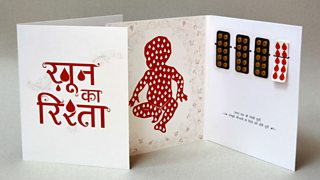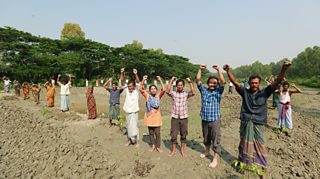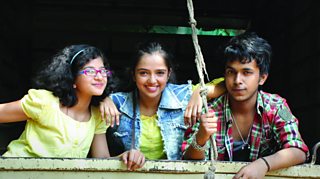Five thought-provoking sessions to attend at the SBCC Summit 2018.
Anna Godfrey
Head of Evidence
Insights from Βι¶ΉΤΌΕΔ Media Action you won't want to miss at the 2018 International Social and Behaviour Change Communication Summit in Nusa Dua, Indonesia
It has been a busy week at the Βι¶ΉΤΌΕΔ Media Action offices as we finalise our preparation for the summit. We will join 1200 people to discuss what works, what doesn’t and where are we now in the field of social and behaviour change communication.
As I pack the team off (being heavily pregnant, I won’t be joining them), with great examples of our creative programming, hard-earned insights and impressive impact data, I’d like to share a preview of our presentations and panels:
1. Human-centred design isn’t all about digital!
Human-centred design (HCD) is creating a buzz. Donors and implementers want to do it, yet few know of practical examples of how it has been applied to development goals.
Our global creative advisor, Radharani Mitra, will be busting the myth that HCD can only be used to create digital solutions. In Bihar, northern India, we took the five key principles of HCD (empathise/immerse, define the problem/mine the insight, ideate, prototype and test) to develop a simple, low cost and creative tool that helps community health workers encourage expectant mothers to take iron and folic acid (IFA) tablets.
In Bihar as few as 12% of expectant mothers take the recommended doses of folic acid and more than 60% are anaemic. We found that women weren’t able to see the connection between their blood count and the baby growing inside them. ‘Khoon ka Rishta’ (blood line) (pictured) is a visual aid that helps mothers link taking each tablet to making their baby healthy using a ‘nudge’ approach.
Does it work?
Yes. On Tuesday 17th April at 10am Radharani will present the feedback and data from our survey with over 2000 new and expectant mothers across 15 districts (eight districts with access to the tools and seven without). We found mothers exposed to the tools were twice as likely to report taking their IFA correctly; health workers who used the tool were more likely to report feeling confident in communicating health information and, aanecdotally, chemists are saying they have noticed an increase in sales of IFA tablets (because, even when women cannot get them free from the system, they are buying the tablets because they realise how fundamental they are to the health of their babies). These insights have helped to inform the policy debate in Bihar where state government has committed funds to scale up the tool across the state.
Whether in Silicon Valley or Bihar – human-centred design can create innovative solutions to problems of every kind.

This oral presentation will be supplemented by the panel - Rethinking communication for maternal and child health: Learnings from three perspectives on Tuesday 17 April 2018 at 14:30 - reflecting on evidence from the wider Shaping Demand and Practice Project funded by Bill and Melinda Gates Foundation in Bihar.
2. A reality TV show can help people in Bangladesh prepare for disaster.
Bangladesh was recently identified as the world’s most disaster-prone country. Yet in 2012, our national survey revealed that over half of Bangladeshis did not know how to respond to adverse weather events or felt unprepared for a future cyclone. That’s why we developed Amrai Pari (Together We Can Do It) – a TV and radio programme, that takes a “makeover” approach and challenges communities to do something together to make their local environment more resilient, all the while working against the clock - of how a village pulled together to help protect a family's house from flooding.
As a result of watching Amrai Pari nearly half (47%) of viewers could name at least one action they had taken to improve their resilience, such as making water safe to drink, storing food and raising the level of their houses. This is encouraging when we estimate that the TV programme and the Public Service Announcements reached 22.5 million people.

Aside from being a really good watch, why did programme work? Well we did some pretty neat modelling (called structural equational modelling for the stats folks out there) that uncovered two important pathways. The first suggested that regular viewers were less likely to feel that they needed government support, which was in turn linked to feeling more confident that they could take action, both individually and with others. And to hear more about the second pathway, join Sonia Whitehead, Head of Research, on Monday 16 April at 15:30 or .
3. A “coming of age” TV drama can break the silence surrounding traditional gender norms in India.
In India, adolescents are often constrained by powerful social norms, including gender norms and expectations, which limit their sense of identity and agency. Silence frequently surrounds sensitive issues such as gender stereotypes, financial independence, child marriage and education, body image and gender-based violence and abuse.
With funding from UNICEF, we developed a ‘whodunit’ television drama called ‘AdhaFULL’ based around three adolescents – Kitty, Tara and Adrak. Each episode sees them encounter these everyday issues and solve a mystery. The TV drama is part of a wider multimedia project, which also uses radio, a smartphone game and outreach materials.

Working with two brilliant academics, Dr Lauren Frank (Portland State University) and Dr. Joyee S. Chatterjee (Asian Institute of Technology), we delivered a mixed methods evaluation including a randomised control trial and qualitative research. One set of young men and women were shown AdhaFULL drama and another group a similar drama. We found that young men who watched AdhaFULL were significantly more likely to be engaged with the show than young men who watched the other drama. AdhaFULL also influenced young men’s levels of self-efficacy (their attitudes and confidence towards “coming of age” issues touched on in the show). Young men who watched AdhaFULL were also significantly more likely to reject traditional gender norms than those who watched a similar drama. To hear more attend the session on Wednesday 18 April at 14:30 and watch this space for our upcoming research briefing.
4. Media and communication is a vital part of the Rohinghya response
Since August last year, Bangladesh has seen an unprecedented arrival of Rohingyas from Myanmar. It is estimated that over a million Rohingya refugees have entered Bangladesh. Fifty eight percent of new arrivals are estimated to be children and 60 % are female. Those who have fled speak of seeing both children and adults killed and women and girls targeted for sexual violence. All are in urgent need of food, medical attention, appropriate shelter, basic hygiene items, and critical social services.
The majority of new arrivals have little knowledge of how to access services or their availability and need information to orient them.. To help the response, UNICEF, Bangladesh Betar, Community Radio Naf and Βι¶ΉΤΌΕΔ Media Action have partnered to reach and engage Rohingya and host communities through radio programming.

Richard Lace, Country Director Bangladesh, will join colleagues from UNICEF on Monday at 15:30 to reflect on how this vital programming is being received. For example, one female listener told us: “When I heard about safe water treatment from the radio programme and practised that, I found the result that my children are not getting sick now.” The discussion will also share learning from those working directly on the emergency ensuring that the voice of communities are heard by - and responded to - by the humanitarian community.
5. Don’t underestimate the power of social norms in driving behaviour change … but make sure you assess if the behaviour is under normative influence in the first place.
This is just one of the tips that will emerge from an exciting panel that we are hosting to discuss social norms. Increasingly, policy-makers, donors, academics and practitioners working in social and behaviour change communication view social norms as a significant factor influencing development outcomes. Rafael Obregon, Chief, C4D at UNICEF, will reflect on four phases of UNICEF’s journey evolving their work in this area over recent years. Rajiv Rimal from George Washington University - a leading academic in this area - will reflect on the current gaps in the evidence and Dr Lauren Frank will contrast her work with Βι¶ΉΤΌΕΔ Media Action’s work, by looking at social networks and norms in Bangladesh with similar research in the United States.
We will share examples of where we have found norms to be important to behaviour change. For example in Ethiopia, we found that it was “normal” for husbands not to be involved in pregnancy because it is a ‘woman’s matter’ and that preparing for birth was thought to bring bad luck. This is why we developed our discussion programme in a way that engaged husbands in preparing for birth and supporting their wives to attend antenatal care. Our found that husbands who listened to the programmes had more supportive attitudes towards antenatal care and expressed supportive social norms than husbands who did not listen. To find out more join the panel on Monday at 11am or keep an eye out for our post panel blog.
You can view the full programme agenda for the summit and a full list of Βι¶ΉΤΌΕΔ Media Action’s sessions .
Follow our tweets
